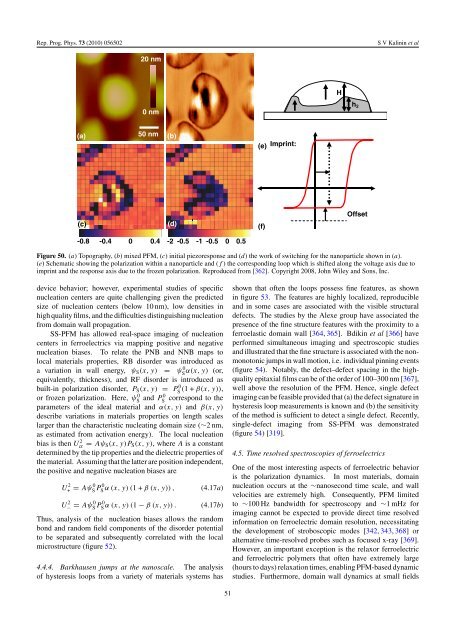Local polarization dynamics in ferroelectric materials
Local polarization dynamics in ferroelectric materials
Local polarization dynamics in ferroelectric materials
You also want an ePaper? Increase the reach of your titles
YUMPU automatically turns print PDFs into web optimized ePapers that Google loves.
Rep. Prog. Phys. 73 (2010) 056502<br />
S V Kal<strong>in</strong><strong>in</strong> et al<br />
20 nm<br />
H<br />
0 nm<br />
h 2<br />
(a)<br />
50 nm<br />
(b)<br />
(e)<br />
Impr<strong>in</strong>t:<br />
(c)<br />
(d)<br />
(f)<br />
Offset<br />
-0.8<br />
-0.4<br />
0<br />
0.4<br />
-2 -0.5 -1<br />
-0.5<br />
0<br />
0.5<br />
Figure 50. (a) Topography, (b) mixed PFM, (c) <strong>in</strong>itial piezoresponse and (d) the work of switch<strong>in</strong>g for the nanoparticle shown <strong>in</strong> (a).<br />
(e) Schematic show<strong>in</strong>g the <strong>polarization</strong> with<strong>in</strong> a nanoparticle and (f ) the correspond<strong>in</strong>g loop which is shifted along the voltage axis due to<br />
impr<strong>in</strong>t and the response axis due to the frozen <strong>polarization</strong>. Reproduced from [362]. Copyright 2008, John Wiley and Sons, Inc.<br />
device behavior; however, experimental studies of specific<br />
nucleation centers are quite challeng<strong>in</strong>g given the predicted<br />
size of nucleation centers (below 10 nm), low densities <strong>in</strong><br />
high quality films, and the difficulties dist<strong>in</strong>guish<strong>in</strong>g nucleation<br />
from doma<strong>in</strong> wall propagation.<br />
SS-PFM has allowed real-space imag<strong>in</strong>g of nucleation<br />
centers <strong>in</strong> <strong>ferroelectric</strong>s via mapp<strong>in</strong>g positive and negative<br />
nucleation biases. To relate the PNB and NNB maps to<br />
local <strong>materials</strong> properties, RB disorder was <strong>in</strong>troduced as<br />
a variation <strong>in</strong> wall energy, ψ S (x, y) = ψS 0 α(x,y) (or,<br />
equivalently, thickness), and RF disorder is <strong>in</strong>troduced as<br />
built-<strong>in</strong> <strong>polarization</strong> disorder, P S (x, y) = PS 0(1+β(x,y)),<br />
or frozen <strong>polarization</strong>. Here, ψS 0 and P S<br />
0 correspond to the<br />
parameters of the ideal material and α(x,y) and β(x,y)<br />
describe variations <strong>in</strong> <strong>materials</strong> properties on length scales<br />
larger than the characteristic nucleat<strong>in</strong>g doma<strong>in</strong> size (∼2 nm,<br />
as estimated from activation energy). The local nucleation<br />
bias is then Ucr 2 = Aψ S(x, y)P S (x, y), where A is a constant<br />
determ<strong>in</strong>ed by the tip properties and the dielectric properties of<br />
the material. Assum<strong>in</strong>g that the latter are position <strong>in</strong>dependent,<br />
the positive and negative nucleation biases are<br />
U+ 2 = Aψ S 0 P S 0 α (x,y)(1+β (x,y)) , (4.17a)<br />
U− 2 = Aψ S 0 P S 0 α (x,y)(1 − β (x,y)) . (4.17b)<br />
Thus, analysis of the nucleation biases allows the random<br />
bond and random field components of the disorder potential<br />
to be separated and subsequently correlated with the local<br />
microstructure (figure 52).<br />
4.4.4. Barkhausen jumps at the nanoscale. The analysis<br />
of hysteresis loops from a variety of <strong>materials</strong> systems has<br />
shown that often the loops possess f<strong>in</strong>e features, as shown<br />
<strong>in</strong> figure 53. The features are highly localized, reproducible<br />
and <strong>in</strong> some cases are associated with the visible structural<br />
defects. The studies by the Alexe group have associated the<br />
presence of the f<strong>in</strong>e structure features with the proximity to a<br />
ferroelastic doma<strong>in</strong> wall [364, 365]. Bdik<strong>in</strong> et al [366] have<br />
performed simultaneous imag<strong>in</strong>g and spectroscopic studies<br />
and illustrated that the f<strong>in</strong>e structure is associated with the nonmonotonic<br />
jumps <strong>in</strong> wall motion, i.e. <strong>in</strong>dividual p<strong>in</strong>n<strong>in</strong>g events<br />
(figure 54). Notably, the defect–defect spac<strong>in</strong>g <strong>in</strong> the highquality<br />
epitaxial films can be of the order of 100–300 nm [367],<br />
well above the resolution of the PFM. Hence, s<strong>in</strong>gle defect<br />
imag<strong>in</strong>g can be feasible provided that (a) the defect signature <strong>in</strong><br />
hysteresis loop measurements is known and (b) the sensitivity<br />
of the method is sufficient to detect a s<strong>in</strong>gle defect. Recently,<br />
s<strong>in</strong>gle-defect imag<strong>in</strong>g from SS-PFM was demonstrated<br />
(figure 54) [319].<br />
4.5. Time resolved spectroscopies of <strong>ferroelectric</strong>s<br />
One of the most <strong>in</strong>terest<strong>in</strong>g aspects of <strong>ferroelectric</strong> behavior<br />
is the <strong>polarization</strong> <strong>dynamics</strong>. In most <strong>materials</strong>, doma<strong>in</strong><br />
nucleation occurs at the ∼nanosecond time scale, and wall<br />
velocities are extremely high. Consequently, PFM limited<br />
to ∼100 Hz bandwidth for spectroscopy and ∼1 mHz for<br />
imag<strong>in</strong>g cannot be expected to provide direct time resolved<br />
<strong>in</strong>formation on <strong>ferroelectric</strong> doma<strong>in</strong> resolution, necessitat<strong>in</strong>g<br />
the development of stroboscopic modes [342, 343, 368] or<br />
alternative time-resolved probes such as focused x-ray [369].<br />
However, an important exception is the relaxor <strong>ferroelectric</strong><br />
and <strong>ferroelectric</strong> polymers that often have extremely large<br />
(hours to days) relaxation times, enabl<strong>in</strong>g PFM-based dynamic<br />
studies. Furthermore, doma<strong>in</strong> wall <strong>dynamics</strong> at small fields<br />
51
















